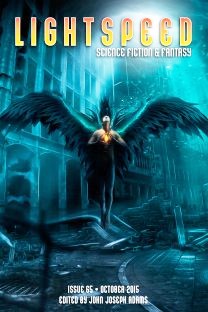“Solder and Steam” by Maria Dahvana Headley
by Rick Cartwright
In “Solder and Seam” Maria Davina Headley has a mature revolutionary in hiding on a depopulated, future Earth where most of the population has moved on to other planets building a wooden whale. A white whale. In the course of the story the retired rebel completes his project and tows it across country to the ocean. Once he arrives, he and the reader get several surprises. On the whole an interesting short story if you like a lot of introspection.
“Children of Dagon” by Adrian Tchaikovsky takes the reader to an England in the distant future where land dwellers and genetically modified sea dwelling humans fight for dominance in a world where global warming has raised the seas and the two groups fight over who should have access to fish from the sea. The point of view is that of a sea dweller warrior and he describes the history that got the world to that place and the resultant battles. In the end it’s an unsatisfactory story with too much bad science and too smug a belief that the land technology would utterly collapse, offering no hope for the future.
“Tragic Business” by Emil Ostrovsk is a delightful fantasy romp that would appeal to fans of Douglas Adams and Monty Python. It chronicles the relationship cycles of a doomed pair as they go through several cycles of rebirth over time and the cosmos. The souls never quite get together, either because one is an apple and the other is a hummingbird, or the same species but as goldfish in adjoining bags of water. You get the idea. The gag is well executed and not overdone. Possibly the best new story in the issue.
“The Karen Joy Fowler Book Club” by Nike Sulway is a fantasy offering that tries to incorporate the classic short story “The Cold Equations” by Tom Godwin in a world where reduced fertility seemed to be pushing the world to extinction. It’s never clear that the characters are human or African animals. The author seems to be trying to say that you can have love with no hope of the future, much like the doomed stowaway in the Godwin story. There are so many extraneous threads in the tale that the author never seems to weave into a coherent whole, and the story leaves the reader cold indeed.
 Lightspeed
Lightspeed